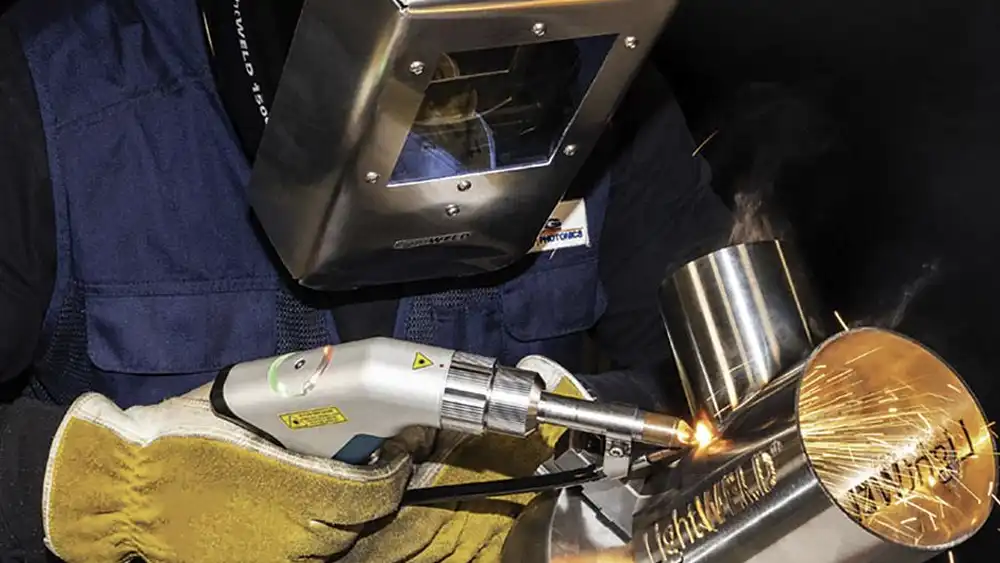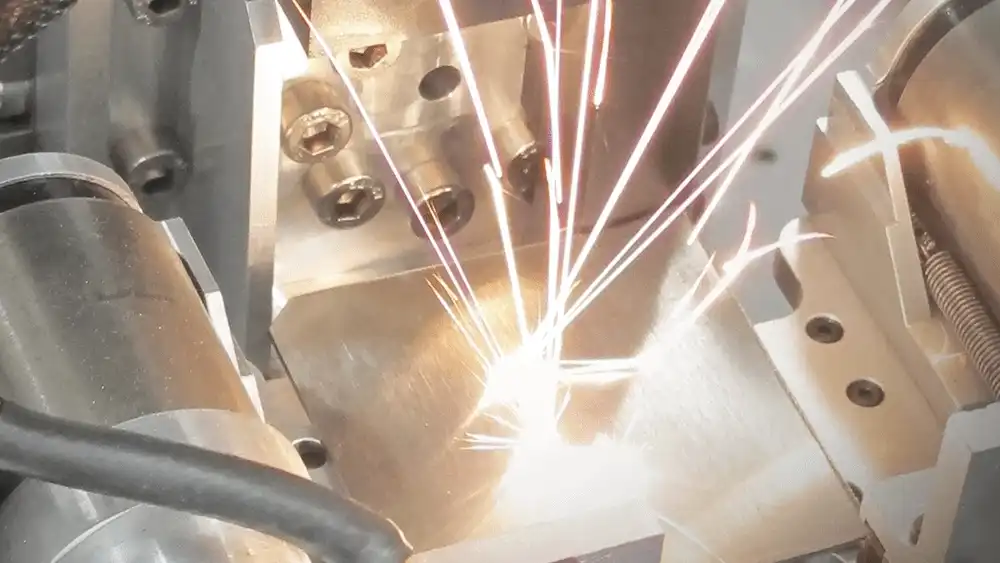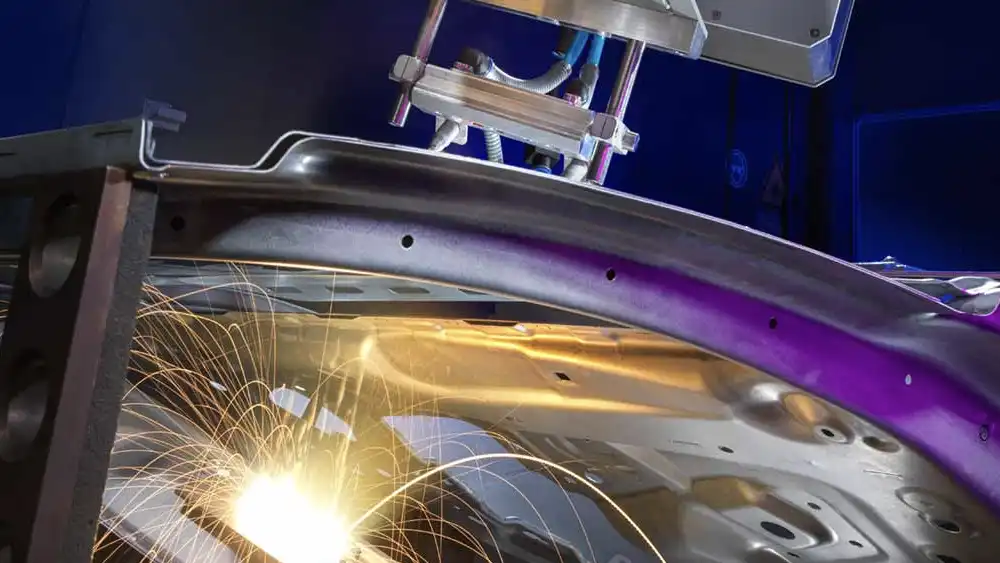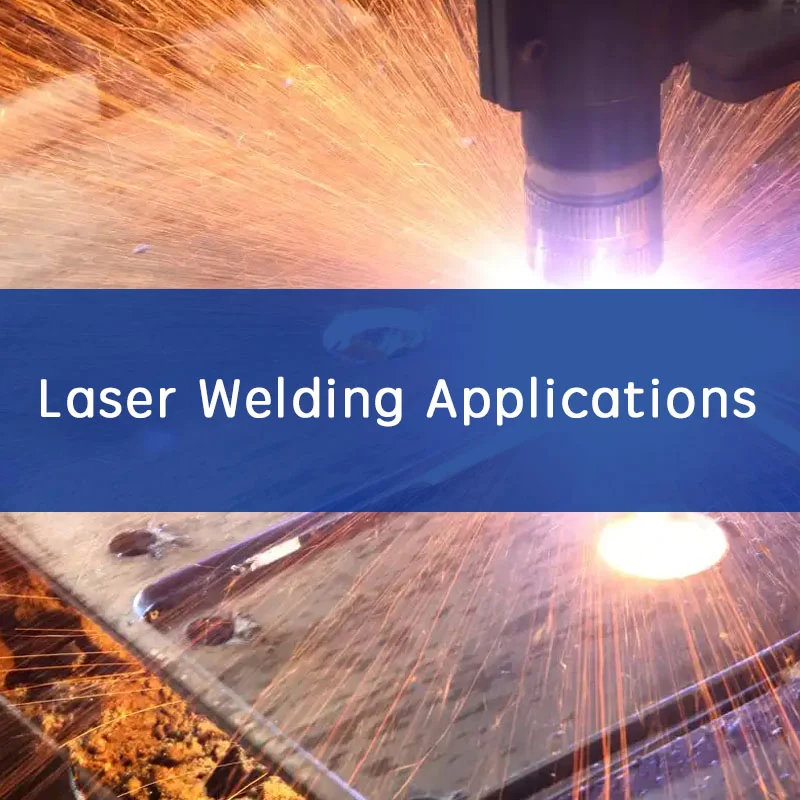The world of welding has undergone a significant transformation in recent times. Gone are the days of bulky equipment and messy processes. Laser welding has emerged as a game-changer, offering unparalleled precision, control, and speed. This innovative technology has weaved its way into the fabric of numerous industries, transforming how we join materials.
In this comprehensive blog post, we’ll embark on a journey to explore 10 remarkable applications of laser welding. We’ll delve into the specifics of each application, highlighting how laser welding tackles challenges and offers unique advantages in various sectors.
What Is Laser Welding

Laser welding is a precise welding technique that utilizes a highly concentrated beam of laser light to join pieces of metal or thermoplastic. Here’s a breakdown of its key characteristics:
Heat Source:
- Unlike traditional arc welding that uses an electric arc to generate heat, laser welding relies on a focused laser beam. This beam creates an intense heat source in a very small area, enabling extremely precise welds.
Material Melting:
- The concentrated heat from the laser beam melts the materials at the joint where the two pieces meet. In some cases, filler material might be added to create a stronger weld.
Advantages:
- Precision: The small, focused nature of the laser beam allows for highly precise welds. This is crucial for applications where tight tolerances and minimal heat impact are essential.
- Cleanliness: Laser welding is a non-contact process, minimizing spatter and fumes compared to traditional welding methods. This creates a cleaner work environment and eliminates the need for extensive post-welding cleaning.
- Strength: Laser welds can be as strong, or even stronger, than the base materials being joined. This makes them suitable for high-strength applications.
- Versatility: Laser welding can handle a wide range of materials, thicknesses, and joint configurations. It can also be used for dissimilar materials that might be difficult to join with traditional methods.
- Automation: Laser welding lends itself well to automation, making it ideal for high-volume production environments.
Laser Welding Applications

Automotive Assembly: Joining with Strength and Speed
Application: Laser welding excels in joining thin, high-strength steels used in car bodies and chassis. Its ability to create narrow, deep welds with minimal heat input minimizes warping and distortion, allowing for lightweight designs crucial for fuel efficiency. In addition to car bodies, laser welding tackles complex parts like:
- Engine components: Joining intricate components like cylinder heads, intake manifolds, and exhaust systems with precise control.
- Fuel injectors: Creating strong, leak-proof seals for fuel injectors, ensuring precise fuel delivery.
- Air conditioning units: Assembling complex air conditioning components with clean welds, minimizing leaks and maximizing efficiency.
Benefits: Laser welding offers several advantages in automotive assembly:
- Enables lightweight designs for improved fuel efficiency.
- Minimizes distortion in thin metal sheets, preserving dimensional accuracy.
- High-speed, automated welding allows for efficient mass production.
Medical Device Manufacturing: Hygiene Meets Precision
Application: Laser welding plays a vital role in medical device manufacturing, where hygiene and precision are paramount. Here’s how it shines:
- Hermetic sealing: Laser welding creates reliable, hermetic seals in pacemakers, defibrillators, and other implantable devices. This ensures sterility and prevents contamination, crucial for long-term functionality within the body.
- Delicate instruments: Laser welding allows for the fabrication of delicate surgical instruments like scalpels and forceps. The precise heat control minimizes heat-affected zones, preserving the critical sharpness and functionality of these instruments.
- Joining dissimilar metals: Laser welding tackles challenges like joining stainless steel and titanium, commonly used in medical implants. This creates strong, biocompatible bonds for long-lasting performance within the body.
Benefits: Laser welding offers significant benefits in medical device manufacturing:
- Promotes biocompatibility by preventing corrosion and contamination.
- Enables complex joint designs for advanced medical devices.
- Minimizes heat distortion for preserving the precision of delicate instruments.
Aerospace Fabrication: Reaching New Heights with Strong, Lightweight Structures
Application: The aerospace industry demands strong, lightweight structures to optimize flight performance. Laser welding steps up to the challenge:
- Challenging materials: Laser welding can join difficult-to-weld materials like titanium and aluminum alloys used in aircraft structures. This creates high-strength welds while minimizing weight, a critical factor for fuel efficiency and payload capacity.
- Fuel lines and heat exchangers: Precise laser welds create reliable seals for critical components like fuel lines and heat exchangers. These leak-proof seals ensure safety and optimal performance within the aircraft systems.
- Turbine blade repair: Laser welding enables targeted repair of cracks or imperfections in turbine blades, extending their lifespan and reducing maintenance costs. The precise heat control minimizes distortion and maintains the critical blade geometry for efficient engine operation.
Benefits: Laser welding offers distinct advantages in aerospace fabrication:
- Enables strong, lightweight structures for improved fuel efficiency and payload capacity.
- Creates reliable seals for critical components, ensuring aircraft safety and performance.
- Allows for targeted repair of turbine blades, reducing maintenance costs and extending engine life.
Electronics Manufacturing: Microwelding for Miniaturization
Application: The miniaturization trend in electronics relies heavily on laser welding’s exceptional control. Here’s how it facilitates this:
- Joining tiny components: Laser welding offers unmatched precision for joining miniature electrical components on circuit boards. This enables the creation of highly-dense, compact electronic devices like smartphones and wearables.
- Minimized heat impact: The focused nature of laser beams minimizes heat transfer to surrounding components, preventing damage to sensitive electronic parts.
- Automated high-volume production: Laser welding lends itself well to automation, allowing for high-speed, high-volume production of complex circuit boards.
Benefits: Laser welding is instrumental in modern electronics manufacturing:
- Enables miniaturization for creating smaller, more powerful electronic devices.
- Protects sensitive components from excessive heat during the welding process.
- Facilitates automated mass production for cost-effective electronics manufacturing.
Jewelry Making: Creating Exquisite Designs with Flawless Joins
Application: Laser welding brings a new level of precision to jewelry making:
- Invisible seams: Laser welding creates clean, virtually invisible seams for delicate jewelry pieces. This allows for intricate designs with a seamless, high-quality finish.
- Joining dissimilar metals: Laser welding tackles the challenge of joining dissimilar metals commonly used in jewelry, like gold and platinum. This creates strong bonds for unique design combinations.
- Minimized heat impact: Precise heat control prevents damage to gemstones or pearls during the welding process, preserving their beauty and value.
Benefits: Laser welding offers significant advantages in jewelry creation:
- Enables the creation of intricate jewelry designs with flawless finishes.
- Allows for joining a wider variety of metals for enhanced design flexibility.
- Minimizes heat impact to protect gemstones and pearls during the welding process.
Consumer Goods Production: Strong, Clean Welds for Everyday Products
Application: Laser welding finds applications beyond high-tech industries, enhancing the production of everyday items:
- Clean and strong welds: Laser welding creates strong, clean welds for enclosures in appliances like refrigerators and washing machines. This eliminates the need for messy adhesives or soldering, improving aesthetics and product lifespan.
- Durable seals: Precise laser welds create strong, leak-proof seals for appliance components, ensuring product functionality and safety.
Benefits: Laser welding offers practical benefits in consumer goods production:
- Provides a clean and aesthetically pleasing finish for appliances and other consumer products.
- Eliminates the need for messy adhesives or soldering, simplifying the manufacturing process.
- Creates strong, durable seals for reliable product performance.
Tool and Die Manufacturing: Building Durable Tools with Precise Joints
Application: Laser welding plays a crucial role in creating long-lasting tools and dies:
- Precise welds: Laser welding allows for the creation of complex tool and die components with highly precise welds. This ensures tight tolerances and accurate part formation during stamping, punching, and other metalworking processes.
- Minimized distortion: The controlled heat input of laser welding minimizes distortion in tool and die components, maintaining their dimensional accuracy for consistent production results.
- Joining dissimilar metals: Laser welding tackles joining challenges like combining tool steel with wear-resistant materials for cutting edges. This creates durable tools with exceptional performance.
Benefits: Laser welding offers significant advantages in tool and die manufacturing:
- Enables the creation of highly precise and accurate tools and dies.
- Minimizes distortion for consistent part production.
- Allows for joining dissimilar metals to create specialized tools with enhanced functionality.
Furniture Manufacturing: Creating Sleek Designs with Invisible Seams
Application: Laser welding brings a touch of sophistication to furniture design:
- Invisible seams: Laser welding creates clean, virtually invisible seams when joining metal components in furniture. This allows for a sleek, modern aesthetic with a seamless look.
- Minimized heat impact: Precise heat control prevents warping or discoloration of metal furniture components, preserving the desired finish.
- Joining dissimilar metals: Laser welding facilitates joining different metals like steel and brass for unique design combinations in furniture pieces.
Benefits: Laser welding offers aesthetic and practical advantages in furniture manufacturing:
- Enables the creation of sleek furniture designs with clean, seamless joints.
- Minimizes heat impact to preserve the desired finish of metal furniture components.
- Allows for joining a wider variety of metals for design flexibility and visual appeal.
Sensor Manufacturing: Precise Assembly for Reliable Performance
Application: Laser welding plays a vital role in ensuring the accuracy and reliability of sensors:
- Precise assembly: Laser welding offers exceptional control for precisely assembling delicate sensor components. This minimizes misalignment and ensures the sensor functions as intended.
- Minimized distortion: The focused heat input of laser welding minimizes distortion in sensor components, preserving their sensitivity and accuracy.
- Joining dissimilar metals: Laser welding allows for joining materials with different electrical properties used in sensors. This creates reliable electrical connections for optimal sensor performance.
Benefits: Laser welding offers significant advantages in sensor manufacturing:
- Enables the precise assembly of delicate sensor components for reliable operation.
- Minimizes distortion to maintain sensor sensitivity and accuracy.
- Allows for joining dissimilar metals for creating sensors with desired electrical properties.
Food and Beverage Packaging: Creating Hermetic Seals for Safety and Preservation
Application: Laser welding plays a vital role in food safety and extended shelf life:
- Hermetic seals: Laser welding creates reliable, hermetic seals for food and beverage packaging. This prevents contamination and ensures food safety for consumers.
- Leak-proof containers: Precise laser welds eliminate the risk of leaks in containers, preserving the quality and freshness of food and beverages.
- Tamper-evident packaging: Laser welding can be used to create tamper-evident seals on packaging, deterring tampering and enhancing food safety.
Benefits: Laser welding offers significant advantages in food and beverage packaging:
- Creates hermetic seals for safe food storage and consumption.
- Provides leak-proof containers to improve product quality and shelf life.
- Enables the creation of tamper-evident packaging for enhanced food safety.
Laser Welding Applications in Automotive Industry

Laser welding has become a critical technology in the automotive industry, offering numerous advantages for car manufacturers. Here’s a breakdown of its key applications and the benefits they bring:
1. Body-in-White (BIW) Assembly:
- Applications: Laser welding excels at joining thin, high-strength steels used in car bodies, chassis components, doors, trunks, and hoods.
- Benefits: Creates strong, lightweight structures for improved fuel efficiency. Minimizes distortion in thin metal sheets, allowing for precise dimensions in car bodies. Enables high-speed, automated welding for efficient mass production.
2. Engine and Powertrain Components:
- Applications: Laser welding tackles complex parts like engine blocks, cylinder heads, intake manifolds, exhaust systems, and fuel injectors.
- Benefits: Creates strong, leak-proof seals for engine components, ensuring optimal performance. Offers precise control for intricate welding patterns in engine parts. Minimizes heat impact to preserve the properties of engine materials.
3. Electric Vehicle (EV) Applications:
- Applications: Laser welding plays a vital role in EV production, joining battery cells, modules, and bus bars for efficient power transfer. It’s also used for welding hairpins in electric motors.
- Benefits: Creates reliable electrical connections for battery packs and motors, crucial for EV performance. Enables precise welding of dissimilar materials commonly used in EV components. Offers a clean and efficient joining method for environmentally friendly vehicles.
4. Other Applications:
- Air conditioning units: Laser welding assembles complex AC components with clean welds, minimizing leaks and maximizing efficiency.
- Sensors: Precise laser welds ensure accurate assembly of delicate sensors in vehicles.
Overall Advantages of Laser Welding in Automotive Industry:
- Stronger, lighter car bodies: Enables weight reduction for improved fuel efficiency and performance.
- High-precision welds: Minimizes distortion and ensures dimensional accuracy in car parts.
- Clean and automated welding: Reduces spatter and fumes, creating a cleaner work environment.
- Versatility: Handles a wide range of materials, thicknesses, and joint configurations.
- Faster production: Enables high-speed, automated welding for efficient car manufacturing.
Laser welding has become an indispensable tool for car manufacturers, shaping the future of the automotive industry with its precision, strength, and efficiency.
Conclusion
As we’ve explored, laser welding tackles challenges in diverse fields, from ensuring the sterility of medical devices to creating strong, lightweight structures for aircraft. Beyond these core applications, its versatility extends to various sectors, from consumer goods production to delicate jewelry making.
The future of laser welding is bright. With ongoing advancements in laser technology, we can expect even more innovative applications to emerge, shaping the future of fabrication with unparalleled precision.
Ready to harness the power of laser welding in your own projects?
Whether you’re a manufacturer seeking to optimize production or a hobbyist exploring new creative possibilities, laser welding offers a powerful solution. Contact us today to get a quote for a laser welding machine that perfectly suits your needs! We offer a wide range of machines with varying capabilities to match your specific requirements and budget. Let’s unlock the potential of laser welding together!

